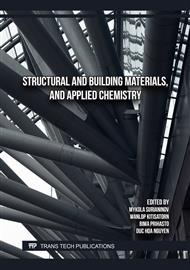[1]
M. Rhode, J. Nietzke, T. Richter, T. Mente, P. Mayr, A. Nitsche, Hydrogen effect on mechanical properties and cracking of creep-resistant 9% Cr P92 steel and P91 weld metal, Weld World, 67 (2023) 183-194.
DOI: 10.1007/s40194-022-01410-5
Google Scholar
[2]
P. Duan, Z. D. Liu, B. Li, J. Y. Li, X. Q. Tao, Study on microstructure and mechanical properties of P92 steel after high-temperature, High Temp. Mater. Process., 39 (2020) 545-555.
DOI: 10.1515/htmp-2020-0087
Google Scholar
[3]
T.H. Nguyen, C.S Nguyen, T.T.H. Phung, A.H. Bui, Effect of temperature on mechanical properties of steel P22 subjected to a constant tensile stress, J. Sci. Technol. Metal., 93 (2020) 2-6.
Google Scholar
[4]
A. Zielinski, G. Golanski, M. Sroka, Assessment of microstructure stability and mechanical properties of X10CrWMo-VNb9-2 (P92) steel after long-term thermal ageing for high temperature applications, Kovove Mater., 54 (2016) 61-70.
DOI: 10.4149/km_2016_1_61
Google Scholar
[5]
S. Fujibayashi, T. Endo, Effect of carbide morphology on the susceptibility to type IV cracking of a 1.25Cr–0.5Mo steel, ISIJ Int., 43 (2003) 790-797.
DOI: 10.2355/isijinternational.43.790
Google Scholar
[6]
K. Ankit, Remaining creep life assessment techniques based on creep cavitation modelling, Metall. Mater. Trans. A, 40 (2009) 1013-1018.
DOI: 10.1007/s11661-009-9781-9
Google Scholar
[7]
A.K. Ray, K. Diwakar, B. N. Prasad, Y. N. Tiwari, R. N. Ghosh, J. D. Whittenberger, Long term creep-rupture behavior of 813K exposed 2.25Cr-1Mo steel between 773 and 873 K, Mater. Sci. Eng. A, 454 (2007) 124-131.
DOI: 10.1016/j.msea.2006.11.020
Google Scholar
[8]
F. Abe, Research and Development of heat-resistant materials for advanced USC power plants with steam temperatures of 700 °C and above, Engineering, 1 (2015) 211-224.
DOI: 10.15302/j-eng-2015031
Google Scholar
[9]
C. Y. Chi, H. Y. Yu, J. X. Dong, W. Q. Liu, S. C. Cheng, Z. D. Liu, X. S. Xie, The precipitation strengthening behavior of Cu-rich phase in Nb contained advanced Fe-Cr-Ni type austenitic heat resistant steel for USC power plant application, Prog. Nat. Sci., 22 (2012) 175-185.
DOI: 10.1016/j.pnsc.2012.05.002
Google Scholar
[10]
B.J. Smith and A.R. Marder, A metallurgical mechanism for corrosion-fatigue (circumferential) crack initiation and propagation in Cr-Mo boiler tube steels, Mater. Charact., 33 (1994) 45-50.
DOI: 10.1016/1044-5803(94)90057-4
Google Scholar
[11]
K. Kucharova, V. Sklenicka, M. Kvapilova, M. Svoboda, Creep and microstructural processes in a low-alloy 2.25%Cr1.6%W steel (ASTM Grade 23), Mater. Charact., 109 (2015) 1-8.
DOI: 10.1016/j.matchar.2015.08.008
Google Scholar
[12]
V. Lazic, D. Milosavljevic, S. Aleksandrovic, P. Marinkovic, G. Bogdanovic, B. Nedeljkovic, Carbide type influence on tribological properties of hard faced steel layer (Part I: Theoretical Considerations), Tribol. Ind., 32 (2010) 11-20.
Google Scholar
[13]
M. Godec and D. A. S. Balantic, Coarsening behaviour of M23C6 carbides in creep-resistant steel exposed to high temperatures, Sci. Rep., 6 (2016) 29734.
DOI: 10.1038/srep29734
Google Scholar
[14]
J. Purbolaksono, J. Ahmad, A. Z. Rashid, A. Khinani, A. A. Ali, Failure analysis on a primary super-heater tube of a power plant, Eng. Fail. Anal., 17 (2010) 158-167.
DOI: 10.1016/j.engfailanal.2009.04.017
Google Scholar
[15]
J. Z. Wang, Z. D. Liu, H. S. Bao, S. C. Cheng, B. Wang, Effect of ageing at 700 °C on microstructure and mechanical properties of S31042 heat resistant steel, J. Iron Steel Res. Int., 20 (2013) 54-58.
DOI: 10.1016/s1006-706x(13)60082-5
Google Scholar
[16]
Z. F Hu, Heat-resistant Steels, Microstructure evolution and life assessment in power plants, mohammad Rasul (Ed.), Thermal power plants; Publisher InTech, Shanghai. (2012) 195-226.
DOI: 10.5772/26766
Google Scholar
[17]
D. R. H. Jones, Creep failures of overheated boiler, super-heater and reformer tubes, Eng. Fail. Anal., 11 (2004) 873-893.
DOI: 10.1016/j.engfailanal.2004.03.001
Google Scholar
[18]
M. E. Kassner, T. A. Hayea, Creep cavitation in metals, Int. J. Plast., 19 (2003) 1715-1748.
Google Scholar



